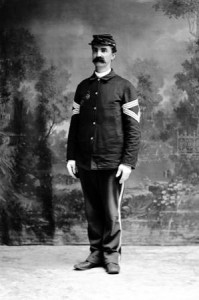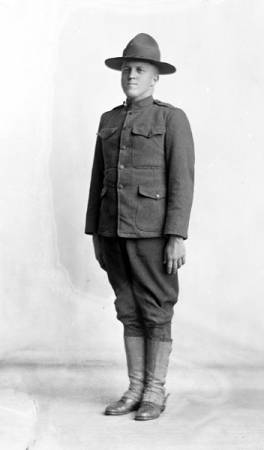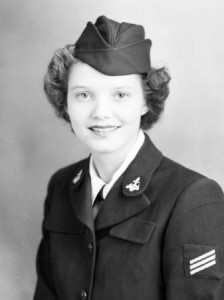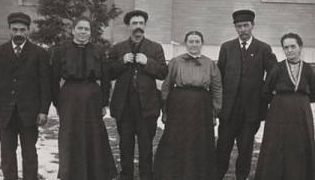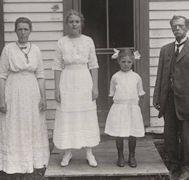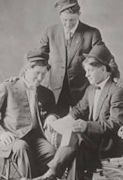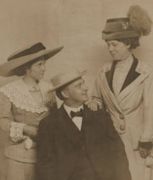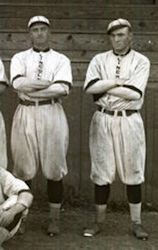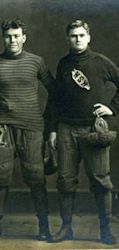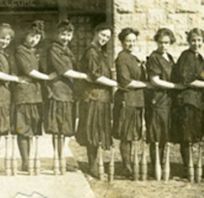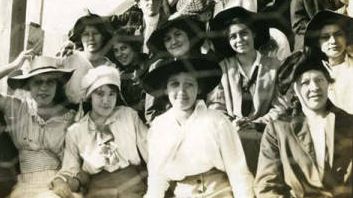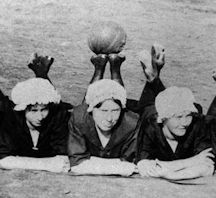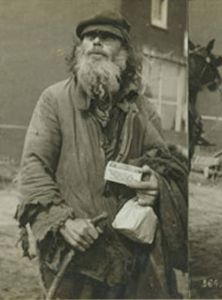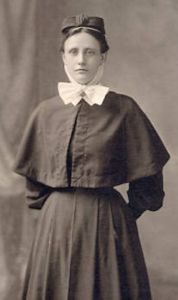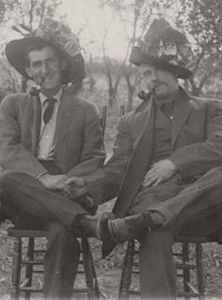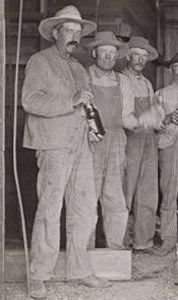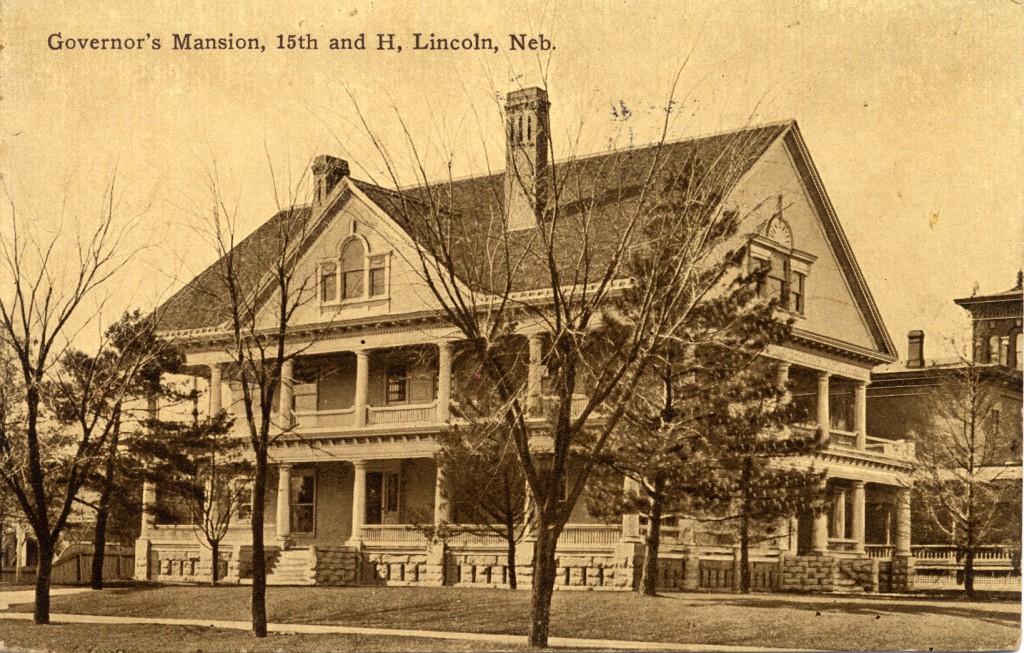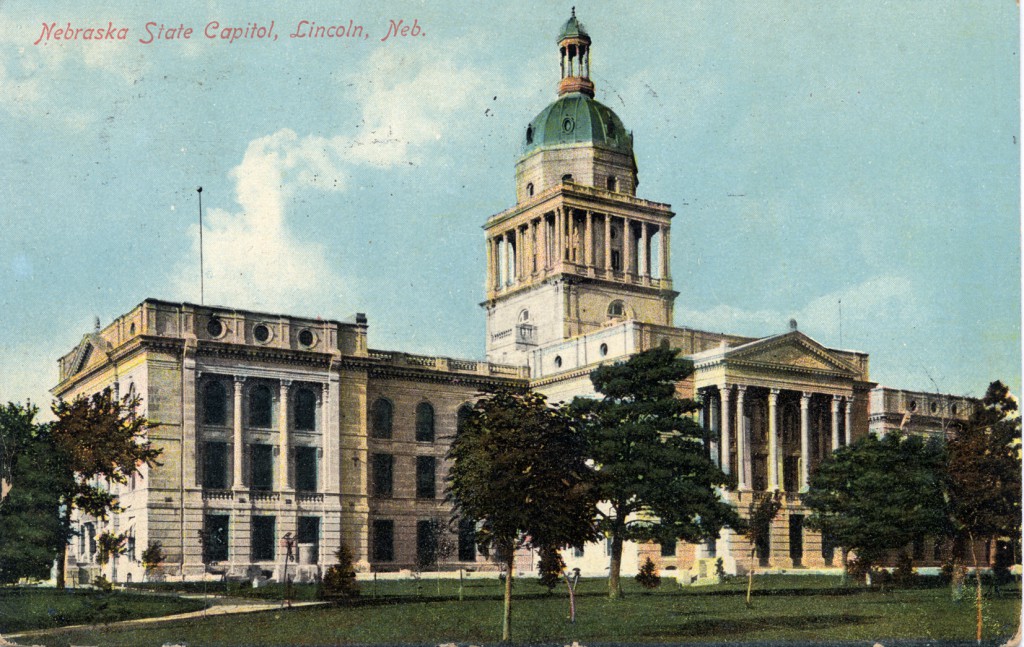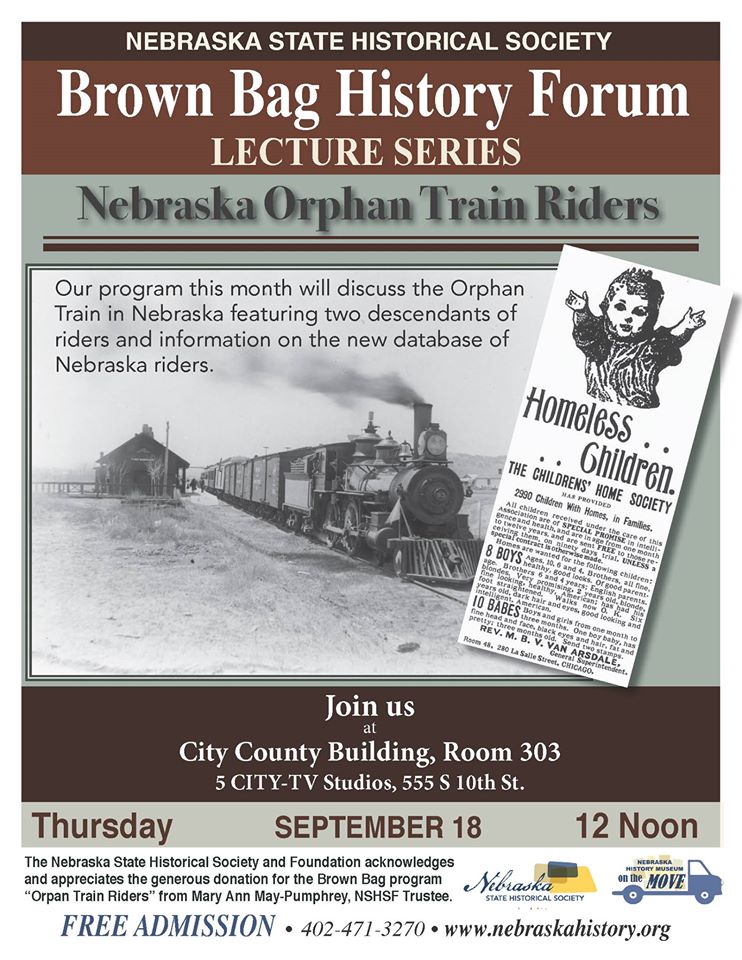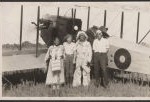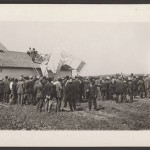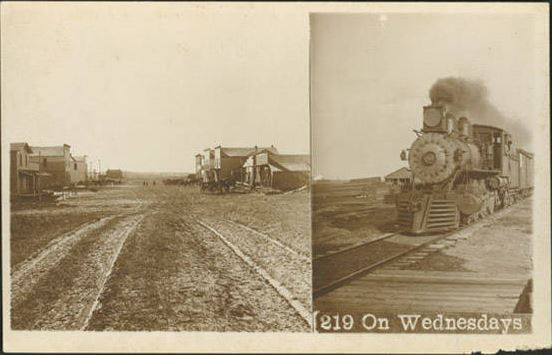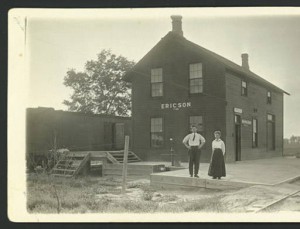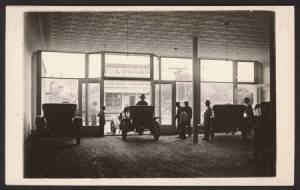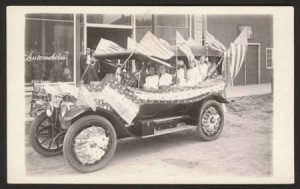Search the Blog
Categories
- Books & Reading
- Broadband Buzz
- Census
- Education & Training
- General
- Grants
- Information Resources
- Library Management
- Nebraska Center for the Book
- Nebraska Libraries on the Web
- Nebraska Memories
- Now hiring @ your library
- Preservation
- Pretty Sweet Tech
- Programming
- Public Library Boards of Trustees
- Public Relations
- Talking Book & Braille Service (TBBS)
- Technology
- Uncategorized
- What's Up Doc / Govdocs
- Youth Services
Archives
Subscribe
Category Archives: Nebraska Memories
Getting the Groceries
Grocery shopping may seem like a pretty mundane thing to blog about. During the holiday season food – getting it, preparing it, sharing it, and reminiscing about previous culinary triumphs and disasters – is part of the celebration. The way we shop for food has changed dramatically with the advent of huge one-stop-shop chain stores and fewer locally owned markets. Fortunately, in Nebraska Memories we can see what some earlier Nebraska food stores looked like because the owners hired photographers for advertising.
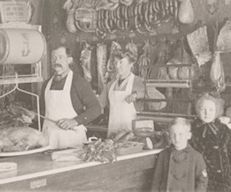 One of the earliest images is a Fred McVay photograph in the Butler County Gallery of the Hrock Meat Market. Joseph Hrock opened the butcher shop in Brainard in 1898, and sold meat from his slaughterhouse on his farm at Loma. We don’t know where the butcher shop in the 1907-1917 era John Nelson photo on the left from the Nebraska State Historical Society collection was located. Sausages, hams and ribs hang on the walls, and best of all there is a turkey on the scale. Was it going to be Thanksgiving or Christmas dinner for the Family in the Shop ?
One of the earliest images is a Fred McVay photograph in the Butler County Gallery of the Hrock Meat Market. Joseph Hrock opened the butcher shop in Brainard in 1898, and sold meat from his slaughterhouse on his farm at Loma. We don’t know where the butcher shop in the 1907-1917 era John Nelson photo on the left from the Nebraska State Historical Society collection was located. Sausages, hams and ribs hang on the walls, and best of all there is a turkey on the scale. Was it going to be Thanksgiving or Christmas dinner for the Family in the Shop ?
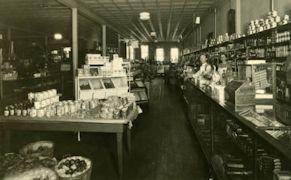 Andrew K. Greenlee, a pioneer settler in Cheyenne County, owned Greenlees Department Store in Sidney. This 1928 photo from the Cheyenne County Historical Society shows the grocery department. It looks quite large with at least two long corridors lined with fresh and canned goods carefully displayed .
Andrew K. Greenlee, a pioneer settler in Cheyenne County, owned Greenlees Department Store in Sidney. This 1928 photo from the Cheyenne County Historical Society shows the grocery department. It looks quite large with at least two long corridors lined with fresh and canned goods carefully displayed .
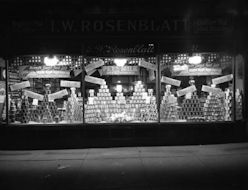 How about the spectacular I.W. Rosenblatt Food Store window display in this 1937 William Wentworth photo from the Durham Museum collection? It must have taken hours to put that together. I can’t imagine the employees actually trying to fetch something from those pyramids for a customer.
How about the spectacular I.W. Rosenblatt Food Store window display in this 1937 William Wentworth photo from the Durham Museum collection? It must have taken hours to put that together. I can’t imagine the employees actually trying to fetch something from those pyramids for a customer.
 Finally, I couldn’t resist including this World War 2 era Wentworth photo of Women shopping in a grocery store. My mother had a full-lenth muskrat coat that looked a lot like the ones these ladies are sporting. I wonder if they drove to the store themselves or were taken by their husbands like my mom, who didn’t learn to drive until the early 70s, was.
Finally, I couldn’t resist including this World War 2 era Wentworth photo of Women shopping in a grocery store. My mother had a full-lenth muskrat coat that looked a lot like the ones these ladies are sporting. I wonder if they drove to the store themselves or were taken by their husbands like my mom, who didn’t learn to drive until the early 70s, was.
Visit Nebraska Memories to search for or browse through many more historical images digitized from photographs, negatives, postcards, maps, lantern slides, books and other materials.
Nebraska Memories is a cooperative project to digitize Nebraska-related historical and cultural heritage materials and make them available to researchers of all ages via the Internet. Nebraska Memories is brought to you by the Nebraska Library Commission. If your institution is interested in participating in Nebraska Memories, see http://nlc.nebraska.gov/nebraskamemories/participation.aspx for more information, or contact Beth Goble, Historical Projects Librarian, or Devra Dragos, Technology & Access Services Director.
Posted in General, Nebraska Memories
2 Comments
Movember, Nebraska Memories Style
Movember is an annual event during which men are encouraged to grow mustaches during the month of November in order to raise awareness of men’s health issues. A glance at the photo gallery on the Movember website reveals some of the striking mustaches grown in support of the cause. The Movember movement started in 2003, but men have been sporting notable mustaches for ages. A number of these mustaches are documented in Nebraska Memories.
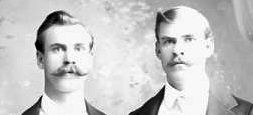 Many of these Nebraskan mustaches are showcased in the portraits of the Butler County Gallery Collection. Ralph Stryker and George Hahn were two men who sat for portraits in the early 1900s, both showing off their mustaches. Growing mustaches (and beards) was clearly a family affair for the four Smith brothers of David City.
Many of these Nebraskan mustaches are showcased in the portraits of the Butler County Gallery Collection. Ralph Stryker and George Hahn were two men who sat for portraits in the early 1900s, both showing off their mustaches. Growing mustaches (and beards) was clearly a family affair for the four Smith brothers of David City.
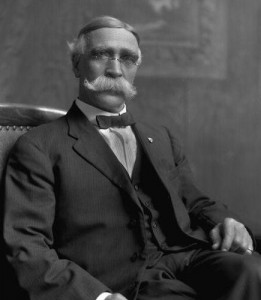 Another notable mustache portrait is found in the Townsend Studio collection. Henry Herpolsheimer, president of Lincoln’s Herpolsheimer Company, sports a long white mustache in his portrait. Joseph M. Rising, a member of the founding family of Rising City, also has a bushy mustache.
Another notable mustache portrait is found in the Townsend Studio collection. Henry Herpolsheimer, president of Lincoln’s Herpolsheimer Company, sports a long white mustache in his portrait. Joseph M. Rising, a member of the founding family of Rising City, also has a bushy mustache.
While most of these mustache photographs date from the late 1800s or early 1900s, interesting mustaches can be found in later photos as well. This German prisoner of war, in a photograph  taken at Camp Atlanta, near Holdrege, during World War II, has a prominent mustache.
taken at Camp Atlanta, near Holdrege, during World War II, has a prominent mustache.
Visit Nebraska Memories to search for or browse through many more historical images digitized from photographs, negatives, postcards, maps, lantern slides, books and other materials.
Nebraska Memories is a cooperative project to digitize Nebraska-related historical and cultural heritage materials and make them available to researchers of all ages via the Internet. Nebraska Memories is brought to you by the Nebraska Library Commission. If your institution is interested in participating in Nebraska Memories, see http://nlc.nebraska.gov/nebraskamemories/participation.aspx for more information, or contact Beth Goble, Historical Services Librarian, or Devra Dragos, Technology & Access Services Director.
Posted in Nebraska Memories
Leave a comment
Remembering Nebraska Veterans
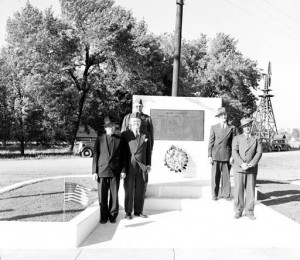 Veterans Day is an official United States holiday that honors people who have served in the U.S. Armed Forces. It is a federal holiday (originally known as Armistice Day) that is observed on November 11 ; that date being chosen because major hostilities of World War I were formally ended at the 11th hour of the 11th day of the 11th month of 1918, when the Armistice went into effect. In 1945, World War II veteran Raymond Weeks from Birmingham, Alabama, had the idea to expand Armistice Day to celebrate all veterans, not just those who died in World War I. Congress officially changed Armistice Day to Veterans Day on June 1, 1954.
Veterans Day is an official United States holiday that honors people who have served in the U.S. Armed Forces. It is a federal holiday (originally known as Armistice Day) that is observed on November 11 ; that date being chosen because major hostilities of World War I were formally ended at the 11th hour of the 11th day of the 11th month of 1918, when the Armistice went into effect. In 1945, World War II veteran Raymond Weeks from Birmingham, Alabama, had the idea to expand Armistice Day to celebrate all veterans, not just those who died in World War I. Congress officially changed Armistice Day to Veterans Day on June 1, 1954.
In honor of our Nebraska veterans, I would like to mention a few of the photographs that can be found in Nebraska Memories. The picture above is of the Veteran’s Memorial in Bruno, Nebraska. The picture to the right is of Orin W. Boston, of David City, Nebraska, wearing his father’s Union Civil War uniform. The picture below is of Clyde Zeilinger, who first served on the Mexican border, then was a medic and a prisoner of war during World War I.
The next photograph is of Evelyn Powell of David City, Nebraska, who served in the US Naval Reserve (Women’s Reserve) during World War II.
Visit Nebraska Memories to search for or browse through many more historical images digitized from photographs, negatives, postcards, maps, lantern slides, books and other materials.
Nebraska Memories is a cooperative project to digitize Nebraska-related historical and cultural heritage materials and make them available to researchers of all ages via the Internet. Nebraska Memories is brought to you by the Nebraska Library Commission. If your institution is interested in participating in Nebraska Memories, see http://nlc.nebraska.gov/nebraskamemories/participation.aspx for more information, or contact Beth Goble, Historical Projects Librarian, or Devra Dragos, Technology & Access Services Director.
Home, Sweet Home, Part I
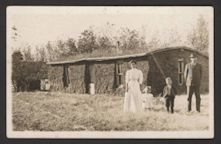 Shelter is one of the most important requirements for people living in a harsh environment. Even though we have been enjoying warm fall weather here in Nebraska recently, temperatures will soon drop and snow will fall and the wind will howl at times during the winter. The first homesteaders settling the prairies didn’t always have much to work with in constructing their homes. A number of them used the sod that lay under their feet, cut and stacked into walls. Sod houses provided protection from the sun, wind, and other natural elements; however, residents sometimes wound up sharing the space with more critters than they would have preferred. Some sod houses were used for many years, into the early 1900s, like this sod house belonging to Ben Miller and his family (Ben Miller family outside of sod house, Nebraska State Historical Society Collection).
Shelter is one of the most important requirements for people living in a harsh environment. Even though we have been enjoying warm fall weather here in Nebraska recently, temperatures will soon drop and snow will fall and the wind will howl at times during the winter. The first homesteaders settling the prairies didn’t always have much to work with in constructing their homes. A number of them used the sod that lay under their feet, cut and stacked into walls. Sod houses provided protection from the sun, wind, and other natural elements; however, residents sometimes wound up sharing the space with more critters than they would have preferred. Some sod houses were used for many years, into the early 1900s, like this sod house belonging to Ben Miller and his family (Ben Miller family outside of sod house, Nebraska State Historical Society Collection).
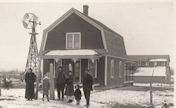 As years went by and their farms became prosperous, families could afford the cost of lumber to build new houses. The farm family in the picture to the right lived in a snug wooden house with a gambrel roof. It does appear that the house is somewhat smaller than the barn in the background, but the barn protected their sources of income (Family in front of wooden house, Nebraska State Historical Society).
As years went by and their farms became prosperous, families could afford the cost of lumber to build new houses. The farm family in the picture to the right lived in a snug wooden house with a gambrel roof. It does appear that the house is somewhat smaller than the barn in the background, but the barn protected their sources of income (Family in front of wooden house, Nebraska State Historical Society).
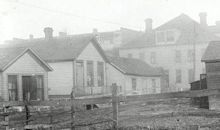 Those families moving west looking for a new life in a larger town, may have wound up in housing such as that to the right. Tenements were built in Omaha in the early 1900s to house not only poor people moving from the east but also immigrants from overseas just as tenements were being built in larger cities such as New York City and Chicago (Tenement houses and alley, Omaha Public Library Collection).
Those families moving west looking for a new life in a larger town, may have wound up in housing such as that to the right. Tenements were built in Omaha in the early 1900s to house not only poor people moving from the east but also immigrants from overseas just as tenements were being built in larger cities such as New York City and Chicago (Tenement houses and alley, Omaha Public Library Collection).
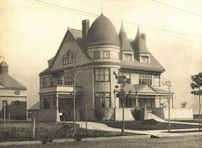 Nebraska residents who made their money quickly often built homes to reflec
Nebraska residents who made their money quickly often built homes to reflec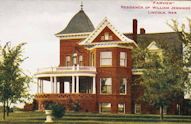 t their wealth. O.M. Carter’s residence to the left was built with wood in the Queen Anne-style of the time. “Fairview”, residence of William Jennings Bryan at the right, also built in a style popular in the United States at the time, was constructed of brick. (Both images from Omaha Public Library Collection.)
t their wealth. O.M. Carter’s residence to the left was built with wood in the Queen Anne-style of the time. “Fairview”, residence of William Jennings Bryan at the right, also built in a style popular in the United States at the time, was constructed of brick. (Both images from Omaha Public Library Collection.)
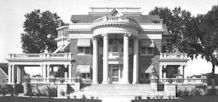 Some homes were even more grandiose. Westfield Acres in Fremont, N
Some homes were even more grandiose. Westfield Acres in Fremont, N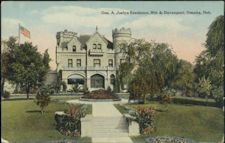 ebraska, to the left, was designed by Alfred C. Class of Ferry and Clas, architects of the 1893 World’s Fair (Westfield Acres, east elevation, Dodge County Historical Society Collection). Joslyn Castle, as its name suggests, was designed along the lines of a European estate house (Geo. A. Joslyn Residence, 39th & Davenport, Omaha, Neb., Omaha Public Library Collection).
ebraska, to the left, was designed by Alfred C. Class of Ferry and Clas, architects of the 1893 World’s Fair (Westfield Acres, east elevation, Dodge County Historical Society Collection). Joslyn Castle, as its name suggests, was designed along the lines of a European estate house (Geo. A. Joslyn Residence, 39th & Davenport, Omaha, Neb., Omaha Public Library Collection).
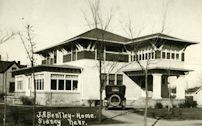 As time passed and other design styles became popular, examples of those homes were also built across Nebraska. J. A. Bentley’s home in Sidney, to the right, is a nice example of the Prairie-style house (J.A. Bentley home, Sidney, Nebr., Cheyenne County
As time passed and other design styles became popular, examples of those homes were also built across Nebraska. J. A. Bentley’s home in Sidney, to the right, is a nice example of the Prairie-style house (J.A. Bentley home, Sidney, Nebr., Cheyenne County 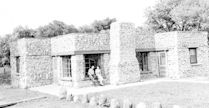 Historical Society and Museum). Floyd Nichols’ home, at the left, is a unique style of architechture for Nebraska and still stands in David City (Floyd Nichols home, Butler County Gallery Collection). Browse other exterior pictures of homes in Nebraska at Nebraska Memories.
Historical Society and Museum). Floyd Nichols’ home, at the left, is a unique style of architechture for Nebraska and still stands in David City (Floyd Nichols home, Butler County Gallery Collection). Browse other exterior pictures of homes in Nebraska at Nebraska Memories.
Visit Nebraska Memories to search for or browse through many more historical images digitized from photographs, negatives, postcards, maps, lantern slides, books and other materials.
Nebraska Memories is a cooperative project to digitize Nebraska-related historical and cultural heritage materials and make them available to researchers of all ages via the Internet. Nebraska Memories is brought to you by the Nebraska Library Commission. If your institution is interested in participating in Nebraska Memories, see http://nlc.nebraska.gov/nebraskamemories/participation.aspx for more information, or contact Beth Goble, Historical Projects Librarian, or Devra Dragos, Technology & Access Services Director.
Posted in Nebraska Memories
Leave a comment
Halloween Inspiration
Are you still searching for that perfect Halloween costume? How about a historic costume inspired by the clothing choices of Nebraskan’s from 100 years ago. You can find plenty of inspiration in Nebraska Memories. There is a wide variety of options ranging from formal to informal attire.
Let’s start out with looking at some of the more formal apparel. Men it looks like you are going to need a three piece suit, shirt, tie and a hat if you have one. Ladies you are going to need a long skirt and a blouse with a high neckline. You may also want to find a hat to complete your outfit.
Men if the idea of wearing a three piece suit doesn’t appeal to you there are plenty of other options. How about dressing as a baseball player from 1914 or a football player from 1909? Ladies if you are going to be sports fan it appears that a hat is required. If you actually want to participate in sports you will need to find a pair of bloomers or a nice ruffled cloth cap.
If you haven’t spotted a winning costume idea yet here are a few more. I really wish we knew the story behind the picture of the two men smoking their pipes while wearing ladies’ hats.
I hope these images provided you with a bit of inspiration as you are working on your Halloween costume. If these looks are a too boring you can always complete the outfit by applying some fake blood and zombie makeup. Just like the folks in these pictures remember not to smile.
Visit Nebraska Memories to search for or browse through many more historical images digitized from photographs, negatives, postcards, maps, lantern slides, books and other materials.
Nebraska Memories is a cooperative project to digitize Nebraska-related historical and cultural heritage materials and make them available to researchers of all ages via the Internet. Nebraska Memories is brought to you by the Nebraska Library Commission. If your institution is interested in participating in Nebraska Memories, see http://nlc.nebraska.gov/nebraskamemories/participation.aspx for more information, or contact Beth Goble, Historical Projects Librarian, or Devra Dragos, Technology & Access Services Director.
Throwback Thursday: Burlington railroad yards, Havelock, Nebraska, circa 1910-1920
Photo of a round house at the Burlington Yards in Havelock, Nebraska. This photograph is part of a collection that was donated to the Library Commission for Nebraska Memories. If you have old Nebraska photos that you would be interested in donating, please contact the Library Commission and check out Nebraska Memories at www.memories.ne.gov.
Posted in General, Nebraska Memories
1 Comment
Throwback Thursday: Old Governor’s Mansion, circa 1910
Posted in General, Nebraska Memories
2 Comments
The Fruits of the Earth
Last Friday, September 26th, was the 240th anniversary of Johnny Appleseed’s birth. Although he died in 1845 and never visited the plains of what would become Nebraska, growing, eating, and celebrating apples have become an important part of harvest time in Nebraska. Last Friday was also the first day of the Applejack Festival in Nebraska City. At this time of year many of us enjoy going to the festival, visiting an orchard, and bringing home apples to fill freezers, pantries and bellies. Plus getting fresh cider to enjoy when the work is done.
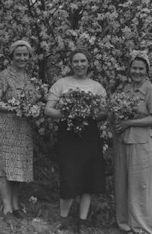 Nebraska Memories participants have contributed several images about apples, from “start to finish”. The smiling ladies in the photo on the left from the Durham Museum collection are holding bouquets of apple blossoms from the trees in the orchard they are standing in. After harvest growers displayed their best at the Nebraska State Fair.
Nebraska Memories participants have contributed several images about apples, from “start to finish”. The smiling ladies in the photo on the left from the Durham Museum collection are holding bouquets of apple blossoms from the trees in the orchard they are standing in. After harvest growers displayed their best at the Nebraska State Fair. 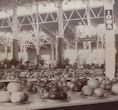 The stereographic photo on the right in the Nebraska State Historical Society collection was taken by John Nelson. A huge variety of apples were on display that year in the Horticulture Building (now called Industrial Arts Building) . Use your imagination to color all these beauties!
The stereographic photo on the right in the Nebraska State Historical Society collection was taken by John Nelson. A huge variety of apples were on display that year in the Horticulture Building (now called Industrial Arts Building) . Use your imagination to color all these beauties! 
After harvest it was also time to preserve such bounty for later enjoyment. The women canning apples in this photo from the Alegent Health Immanual Medical Center collection worked at the Immanuel Deaconess Institute. They already have quite a few jars made!
Visit Nebraska Memories to search for or browse through many more historical images digitized from photographs, negatives, postcards, maps, lantern slides, books and other materials.
Nebraska Memories is a cooperative project to digitize Nebraska-related historical and cultural heritage materials and make them available to researchers of all ages via the Internet. Nebraska Memories is brought to you by the Nebraska Library Commission. If your institution is interested in participating in Nebraska Memories, see http://nlc.nebraska.gov/nebraskamemories/participation.aspx for more information, or contact Beth Goble, Historical Services Librarian, or Devra Dragos, Technology & Access Services Director.
Posted in General, Nebraska Memories
Leave a comment
Webinar: Grant Writing for Preservation and Access Digitization Projects
A live training webinar, “Grant Writing for Preservation and Access Digitization Projects,” will be presented on September 30, 2014.
This webinar has been rescheduled. Registration is open to any new registrants. Those who have already registered do not have to re-register. Your previous registration will carry over to the new date.
Register today for “Grant Writing for Preservation and Access Digitization Projects”
- Start time: 2 p.m. Eastern Time
- Duration: 60 minutes
- Speaker: David Walls, Preservation Librarian, U.S. Government Printing Office
- Learning outcomes: The webinar will cover: preparing for your grant proposal, matching your project to the appropriate funding agency, writing an effective grant proposal while avoiding common faults, and understanding the review process.
- Expected level of knowledge for participants: No prerequisite knowledge required.
The webinar is free, however registration is required. Upon registering, a confirmation email will be sent to you. This registration confirmation email includes the instructions for joining the webinar.
Registration confirmations will be sent from sqldba @ icohere.com. To ensure delivery of registration confirmations, registrants should configure junk mail or spam filter(s) to permit messages from that email address. If you do not receive the confirmation, please notify GPO at FDLPOutreach.
GPO’s eLearning platform is now presenting webinars using WebEx. In order to attend or present at a GPO-hosted webinar, a WebEx plug-in must be installed in your internet browser(s). Download instructions.
For access to other archived Federal Depository Library Program webinars and webcasts and for a calendar of upcoming webinars and educational events, please visit the Training and Events page on FDLP.gov.
Throwback Thursday: Old Nebraska State Capitol Building, circa 1909
Posted in General, Nebraska Memories
1 Comment
Brown Bag History Forum: Nebraska Orphan Train Riders
You Can Take It To The Bank
The first bank in Nebraska was established even before Nebraska became a state. The Kountze Brothers Bank was opened in Omaha in 1857, when Nebraska was still a territory. It later became First National Bank of Omaha. As more and more of Nebraska was settled, more banks were established. Nebraska Memories contains many images of banks in 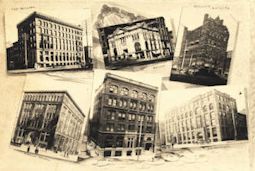 Nebraska cities and towns, from many different points in the history of the state.
Nebraska cities and towns, from many different points in the history of the state.
First National was just one of many banks in Omaha. This print from the 1880s shows five different Omaha banks, only a few of the city’s banking institutions.
Of course, smaller towns in Nebraska had banks, too. The bank in Sidney in 1900 shared a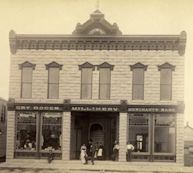 stone building with a dry goods store and a millinery shop. This image of the Bank of
stone building with a dry goods store and a millinery shop. This image of the Bank of 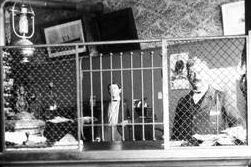 Brainard gives us a glimpse into the interior of an early twentieth century bank.
Brainard gives us a glimpse into the interior of an early twentieth century bank.
A slightly more recent picture, from the 1920s, shows a bank in Richfield, Nebraska. My 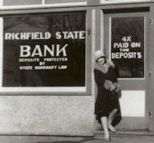 co-workers and I were commenting that the four percent interest rate advertised in the window is better than what we are currently receiving on our accounts!
co-workers and I were commenting that the four percent interest rate advertised in the window is better than what we are currently receiving on our accounts!
Visit Nebraska Memories to search for or browse through many more historical images digitized from photographs, negatives, postcards, maps, lantern slides, books and other materials.
Nebraska Memories is a cooperative project to digitize Nebraska-related historical and cultural heritage materials and make them available to researchers of all ages via the Internet. Nebraska Memories is brought to you by the Nebraska Library Commission. If your institution is interested in participating in Nebraska Memories, see http://nlc.nebraska.gov/nebraskamemories/participation.aspx for more information, or contact Beth Goble, Historical Services Librarian, or Devra Dragos, Technology & Access Services Director.
Posted in Nebraska Memories
2 Comments
Planes, Trains, and Automobiles
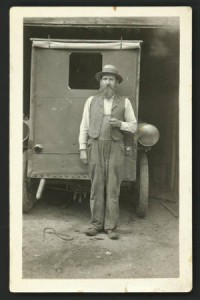 One of the fun things I like to do while browsing through Nebraska Memories is to find pictures that remind me of a phrase or movie title, then add a Nebraska twist. That led me to today’s post about Nebraska photographer John Nelson, and the movie “Planes, Trains, and Automobiles.”
One of the fun things I like to do while browsing through Nebraska Memories is to find pictures that remind me of a phrase or movie title, then add a Nebraska twist. That led me to today’s post about Nebraska photographer John Nelson, and the movie “Planes, Trains, and Automobiles.”
John Nelson was born in Halestad, Sweden in 1864. He came to Nebraska with his parents at the age of seventeen. His many photographs tell the story of small town life in Nebraska during the first decades of the 20th century. His subjects included people, towns, businesses, community activities, early airplanes, trains, and automobiles.
The picture to the left is of the photographer himself, standing in front of the rear end of his motorized portable darkroom, between 1907 and 1917.
The pictures immediately below are the first stop in the planes, trains, and automobiles tour. They are of a biplane with its’ pilot, two Native Americans and a woman, and then a crowd of onlookers at the site of an airplane crash, respectively, about the same time period. These are just two of several airplane photographs taken by John Nelson found in Nebraska Memories, and illustrate the variety of pictures he took.
Trains are our next stop in the planes, trains and automobiles tour. Mr. Nelson took photographs of the trains themselves, but also took photographs of the people and places associated with the railroads. This can be seen in the pictures below of the “219 on Wednesdays” coming into a small Nebraska town, and in the picture of a couple standing outside the Ericson, Nebraska train depot.
Then last on the tour, but certainly not least, are the pictures of automobiles. John Nelson took many pictures of cars: everything from cars in downtown Omaha to individuals in or beside their cars, and from the F.J. O’Hara Buick Dealership in Spalding, Nebraska to automobiles decorated for parades, as seen below.
I hope you’ve enjoyed our photographic tour of John Nelson’s planes, trains, and automobiles. Visit Nebraska Memories to search for or browse through many more historical images digitized from photographs, negatives, postcards, maps, lantern slides, books and other materials.
Nebraska Memories is a cooperative project to digitize Nebraska-related historical and cultural heritage materials and make them available to researchers of all ages via the Internet. Nebraska Memories is brought to you by the Nebraska Library Commission. If your institution is interested in participating in Nebraska Memories, see http://nlc.nebraska.gov/nebraskamemories/participation.aspx for more information, or contact Beth Goble, Historical Projects Librarian, or Devra Dragos, Technology & Access Services Director.
Posted in Nebraska Memories
Leave a comment
Dining Out
Did you run out and pick up lunch today? Do you plan to eat out tonight? Are you out on the road and need a place to eat?
 People have had a variety of choices for cafes, restaurants, steak houses, etc. in Nebraska over the years. Options included formal and informal. Al fresco dining outside this restaurant was offered in the early 1900s. The photograph to the left captures a crowd at a restaurant offering an outside lunch counter option (Nebraska State Historical Society Collection). Photographer John Nelson took many pictures in the area surrounding Wheeler County where he lived.
People have had a variety of choices for cafes, restaurants, steak houses, etc. in Nebraska over the years. Options included formal and informal. Al fresco dining outside this restaurant was offered in the early 1900s. The photograph to the left captures a crowd at a restaurant offering an outside lunch counter option (Nebraska State Historical Society Collection). Photographer John Nelson took many pictures in the area surrounding Wheeler County where he lived.
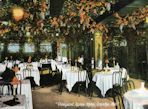
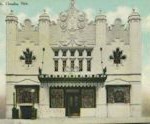 More formal dining at about the same time was in order at the Vineyard in Omaha’s Rome Hotel at 16th and Jackson Streets, shown in the postcard far left. The wait staff there may have been as numerous as that of the Calumet Restaurant (1411-1413 Douglas Street, Omaha) shown in the postcard bottom left. Tolf Hanson, after selling the Calumet to his brother-in-law, opened Hanson’
More formal dining at about the same time was in order at the Vineyard in Omaha’s Rome Hotel at 16th and Jackson Streets, shown in the postcard far left. The wait staff there may have been as numerous as that of the Calumet Restaurant (1411-1413 Douglas Street, Omaha) shown in the postcard bottom left. Tolf Hanson, after selling the Calumet to his brother-in-law, opened Hanson’ s Cafe in 1908, a tony restaurant that didn’t quite catch on despite extensive, expensive interior renovations. The building now houses the Omaha’s oldest Chinese restaurant at 315 S. 16th Street. (Omaha Public Library Collection)
s Cafe in 1908, a tony restaurant that didn’t quite catch on despite extensive, expensive interior renovations. The building now houses the Omaha’s oldest Chinese restaurant at 315 S. 16th Street. (Omaha Public Library Collection)
Steak houses have also been big in Nebraska for a number of years. 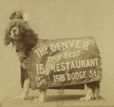 The Denver Chop House at 1518 Dodge Street, used cutting edge advertising in 1894, to promote their 15 Cent Restaurant on the postcard at the top left (Omaha
The Denver Chop House at 1518 Dodge Street, used cutting edge advertising in 1894, to promote their 15 Cent Restaurant on the postcard at the top left (Omaha 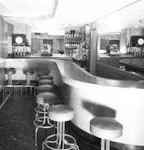 Public Library Collection). Opening somewhat later, Gorat’s Steakhouse, 4917 Center Street, Omaha, was and is a popular dining establishment. Cooks in the basement kitchen of Gorat’s Steak House cut generous portions of steak in the 1949 photograph at the left.
Public Library Collection). Opening somewhat later, Gorat’s Steakhouse, 4917 Center Street, Omaha, was and is a popular dining establishment. Cooks in the basement kitchen of Gorat’s Steak House cut generous portions of steak in the 1949 photograph at the left. 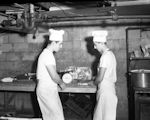 While upstairs in the photograph to the right, patrons could enjoy a drink at the sleek bar before eating. (The Durham Museum Collection)
While upstairs in the photograph to the right, patrons could enjoy a drink at the sleek bar before eating. (The Durham Museum Collection)
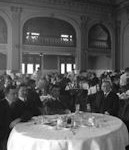
 In Lincoln, businessmen could eat formally in the Commercial Club dining room on an upper floor of 1110 P Street as they do in the photograph to the left. Or someone in a hurry could grab a bite at the Jenquenz Sanitary Lunch Car a few blocks away at 222 S. 11th Street shown in the photograph to the right. (Townsend Studio Collection)
In Lincoln, businessmen could eat formally in the Commercial Club dining room on an upper floor of 1110 P Street as they do in the photograph to the left. Or someone in a hurry could grab a bite at the Jenquenz Sanitary Lunch Car a few blocks away at 222 S. 11th Street shown in the photograph to the right. (Townsend Studio Collection)
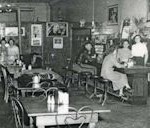
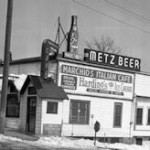 Locals and teenagers had their own favorite hangouts. Mrs. Tony’s Cafe in Fairmont with its pinball machine was popular with young people in town shown at left. (Fairmont Public Library Collection) Marchio’s Italian Cafe was part of the neighborhood at 13th and J Streets in Omaha, photograph to the right. (The Durham Museum Collection)
Locals and teenagers had their own favorite hangouts. Mrs. Tony’s Cafe in Fairmont with its pinball machine was popular with young people in town shown at left. (Fairmont Public Library Collection) Marchio’s Italian Cafe was part of the neighborhood at 13th and J Streets in Omaha, photograph to the right. (The Durham Museum Collection) 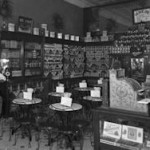 And anyone wanting something from the soda fountain had many choices in Lincoln, including Joe Gatto’s Store, to the left. (Townsend Studio Collection)
And anyone wanting something from the soda fountain had many choices in Lincoln, including Joe Gatto’s Store, to the left. (Townsend Studio Collection)
So, where are we going and what’s for dinner?
Visit Nebraska Memories to search for or browse through many more historical images digitized from photographs, negatives, postcards, maps, lantern slides, books and other materials.
Nebraska Memories is a cooperative project to digitize Nebraska-related historical and cultural heritage materials and make them available to researchers of all ages via the Internet. Nebraska Memories is brought to you by the Nebraska Library Commission. If your institution is interested in participating in Nebraska Memories, see http://nlc.nebraska.gov/nebraskamemories/participation.aspx for more information, or contact Beth Goble, Historical Projects Librarian, or Devra Dragos, Technology & Access Services Director.
Posted in General, Information Resources, Nebraska Memories
Leave a comment
Donating to Nebraska Memories
Do you have some neat historical photos, postcards or documents at home that you think would be good additions to Nebraska Memories? Are you willing to donate them to the Library Commission? If yes, read on.
Most of the content in Nebraska Memories comes from non-profit organizations contributing images of materials that they retain ownership of. Did you know that now we also accept donations of pre-approved historical, Nebraska-related materials from individuals? These items may include photographs, negatives, postcards, maps, and documents such as letters, diaries, deeds, diplomas, and event programs.
We recently added a new collection to Nebraska Memories called Donated Materials which currently includes photographs, postcards, and autograph albums. Click on the Browse this Collection button and click on the thumbnail images to see what we have so far.
The three items shown here were donated by Vicki Witmer, who is credited in the image descriptions as the donor. Two are postcards of landmarks in the town of Havelock Nebraska, which was founded in 1893. The photos were taken in the 1920’s before Havelock was annexed by the city of Lincoln in 1930.
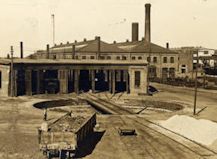 I am fascinated by the turntable in the Burlington Yards postcard., and imagine huge engines rotating on it while being worked on or turned around to begin a new journey in the other direction.
I am fascinated by the turntable in the Burlington Yards postcard., and imagine huge engines rotating on it while being worked on or turned around to begin a new journey in the other direction. 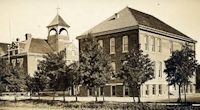 I can also imagine children of railroad workers, most of whom probably lived in Havelock, walking to the nearby Public School while a parent (likely the father) walked to work at the yards. The school building looks rather forbidding, but many did in those days.
I can also imagine children of railroad workers, most of whom probably lived in Havelock, walking to the nearby Public School while a parent (likely the father) walked to work at the yards. The school building looks rather forbidding, but many did in those days.
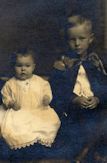 This Dole Studio, Lincoln portrait of Enid and Neil Holt was also taken in the 1920’s. Could they have lived in Havelock? I hope seeing these donated images whets your appetite for helping us tell Nebraska’s story. If you have Nebraska –related historical items that you would like to donate, follow this link for more information. http://nlc.nebraska.gov/nebraskamemories/donations.aspx
This Dole Studio, Lincoln portrait of Enid and Neil Holt was also taken in the 1920’s. Could they have lived in Havelock? I hope seeing these donated images whets your appetite for helping us tell Nebraska’s story. If you have Nebraska –related historical items that you would like to donate, follow this link for more information. http://nlc.nebraska.gov/nebraskamemories/donations.aspx
Visit Nebraska Memories to search for or browse through many more historical images digitized from photographs, negatives, postcards, maps, lantern slides, books and other materials.
Nebraska Memories is a cooperative project to digitize Nebraska-related historical and cultural heritage materials and make them available to researchers of all ages via the Internet. Nebraska Memories is brought to you by the Nebraska Library Commission. If your institution is interested in participating in Nebraska Memories, see http://nlc.nebraska.gov/nebraskamemories/participation.aspx for more information, or contact Beth Goble, Historical Projects Librarian, or Devra Dragos, Technology & Access Services Director.
Posted in General, Information Resources, Nebraska Memories
1 Comment
Do you have 10 minutes to help us transcribe a handwritten inscription?
 Recently we added two autograph albums to Nebraska Memories. The albums belonged to May Martin Ellis and her husband John Ellis. They contain many handwritten inscriptions with the majority of inscriptions dating from the late 1800’s. While it is fun to read the inscriptions it can also be a challenge to read some of the handwriting. We would like to remove this challenge by providing a typed transcription of each page. Typing the transcriptions is a bit of a daunting task however because there are about 150 pages between the two albums and each page was written by a different person. The quality of handwriting varies from page to page so some are easy to read while others take a bit more effort.
Recently we added two autograph albums to Nebraska Memories. The albums belonged to May Martin Ellis and her husband John Ellis. They contain many handwritten inscriptions with the majority of inscriptions dating from the late 1800’s. While it is fun to read the inscriptions it can also be a challenge to read some of the handwriting. We would like to remove this challenge by providing a typed transcription of each page. Typing the transcriptions is a bit of a daunting task however because there are about 150 pages between the two albums and each page was written by a different person. The quality of handwriting varies from page to page so some are easy to read while others take a bit more effort.
 To help with the task of transcribing these albums we wanted to try using crowdsourcing. If you are not familiar with crowdsourcing in this context it is a way to divide up the labor of transcribing the text among a group of people who are willing to give a few minutes of their time to the project. This is not a new concept but it is the first time we are trying it and hope you will be willing to help us.
To help with the task of transcribing these albums we wanted to try using crowdsourcing. If you are not familiar with crowdsourcing in this context it is a way to divide up the labor of transcribing the text among a group of people who are willing to give a few minutes of their time to the project. This is not a new concept but it is the first time we are trying it and hope you will be willing to help us.
What do you get out of helping with this project? To start with you get the enjoyment of reading a page or two in the autograph books. While I haven’t read all of the pages yet here is one inscription that I found amusing. This is from page 42 of May’s album.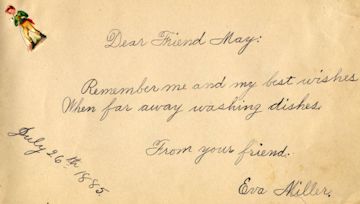
Dear Friend May:
Remember me and my best wishes
When far away washing dishes.
From your friend.
Eva Miller.
July 26th 1885.
Second, by helping to create a typed transcription we are making both the inscriptions and the name of the person who wrote them legible, searchable and findable. After the pages have been transcribed we will add the transcribed text to the corresponding album page in Nebraska Memories.
Third, if your relatives lived in Nebraska during the late 1800’s maybe you will find an inscription they wrote. Many of the inscriptions include both a date and place name. Some of the place names I’ve seen include: Alliance, Box Butte, Genoa, Hemingford, Osceola, and Grand Lake (According to information on the Nebraska State Historical Site’s webpage Grand Lake was located near Alliance.)
If you are up to the challenge here is how you can help. We have set up a Google form for each album so we can easily collect the transcribed text and then display the text in a corresponding spreadsheet. You do not need a Google account to help us. Everything you do is anonymous. We have no way of tracking who has helped us with this project. Here is what you need to get started.
Links That You Will Need – Please make sure you read the instructions below.
May Martin Ellis Album
UPDATE: Thanks to everyone’s help the May Martin Ellis Album is done.
Album: http://memories.nebraska.gov/cdm/ref/collection/donated/id/127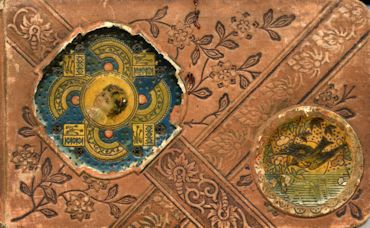
Spreadsheet: http://goo.gl/ZVFXwx
Form: http://goo.gl/ebYc52
John Ellis Album
UPDATE: Thanks to everyone’s help the John Ellis Album is done.
Album: http://memories.nebraska.gov/cdm/ref/collection/donated/id/178
Spreadsheet: http://goo.gl/TOvyi2
Form: http://goo.gl/D2rDfx
Instructions
- Open either May’s or John’s spreadsheet. On the spreadsheet you will see a column labeled Page. If a page number is listed in the spreadsheet that means the page has been transcribed. You will see the transcription in the corresponding column. Determine which page or pages need to be transcribed.
- Open the corresponding album and locate a page you want to transcribe.
- Open the corresponding form. Enter the number of the page you are transcribing and then type the text as it is written.
- Press the enter key at the end of each line.
- Do NOT correct misspellings, grammar errors, punctuation, odd capitalization or anything else we may consider wrong. I know this may be the hardest part for some folks but it is important that you type the text exactly as it was written. For example I’ve seen a couple of folks who have written the word tomorrow as two separate words. In May’s book on page 6 her Pa wrote it as “to Morrow”. That’s the way it needs to be typed.
 If you cannot read a word, letter or are unsure of something please put a question mark in the transcription at the point you have the question. The question mark will be a signal to us that someone else will need to look at that text. For example if I was transcribing page 20 of John’s book there is a line where I would need to insert a question mark because I’m not sure what is written between the word in and albums. In the form I would enter: If scribbling in ? Albums:
If you cannot read a word, letter or are unsure of something please put a question mark in the transcription at the point you have the question. The question mark will be a signal to us that someone else will need to look at that text. For example if I was transcribing page 20 of John’s book there is a line where I would need to insert a question mark because I’m not sure what is written between the word in and albums. In the form I would enter: If scribbling in ? Albums: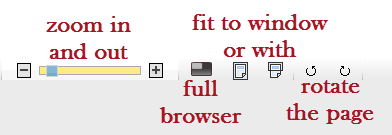 Some folks wrote at all kinds of odd angles. You may need to rotate or zoom in on the text to make it easier to read. Use the buttons on the toolbar above the image to do this. Put the text in the order you think is most logical.
Some folks wrote at all kinds of odd angles. You may need to rotate or zoom in on the text to make it easier to read. Use the buttons on the toolbar above the image to do this. Put the text in the order you think is most logical.- If you see a transcription in the spreadsheet with a questions mark in it and you want to try deciphering that page please go ahead and try. Multiple forms can be submitted for each page. We will be looking at all of the transcriptions before they are added to Nebraska Memories.
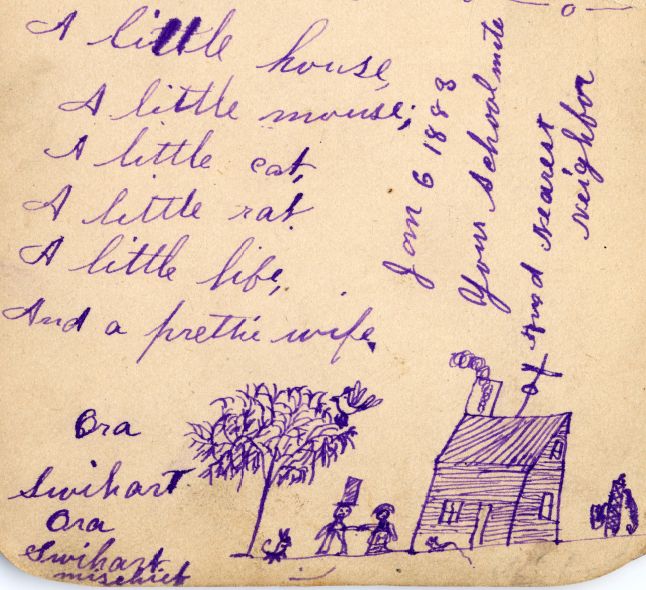 Now that you have spent five minutes reading this I hope you will be willing to spend 5 more minutes transcribing a page or two in the albums. You never know what funny saying you may transcribe.
Now that you have spent five minutes reading this I hope you will be willing to spend 5 more minutes transcribing a page or two in the albums. You never know what funny saying you may transcribe.
Thank for your help. If you have any questions please leave a comment or send me an email.
Visit Nebraska Memories to search for or browse through many more historical images digitized from photographs, negatives, postcards, maps, lantern slides, books and other materials.
Nebraska Memories is a cooperative project to digitize Nebraska-related historical and cultural heritage materials and make them available to researchers of all ages via the Internet. Nebraska Memories is brought to you by the Nebraska Library Commission. If your institution is interested in participating in Nebraska Memories, see http://nlc.nebraska.gov/nebraskamemories/participation.aspx for more information, or contact Beth Goble, Historical Projects Librarian, or Devra Dragos, Technology & Access Services Director.
Posted in General, Information Resources, Nebraska Memories, Technology
1 Comment
Rising City Memories
An assortment of items from Rising City Community Library joins Nebraska Memories as its newest collection. The photographs and postcards in the collection highlight many aspects of Rising City’s history.
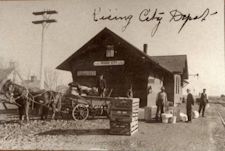 Rising City was established when the Omaha & Republican Valley Railroad was extended across Butler County in 1878, and the collection includes photographs that show the town’s railroad roots. In this photograph, the town’s railroad depot appears to be a site of bustling activity.
Rising City was established when the Omaha & Republican Valley Railroad was extended across Butler County in 1878, and the collection includes photographs that show the town’s railroad roots. In this photograph, the town’s railroad depot appears to be a site of bustling activity.
The establishment of the railroad brought increased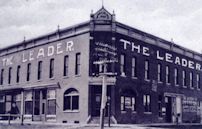 population to the area, and businesses grew accordingly. The business community of Rising City is well represented in this collection. Images of local businesses, including a hotel, banks, and a meat market, provide a
population to the area, and businesses grew accordingly. The business community of Rising City is well represented in this collection. Images of local businesses, including a hotel, banks, and a meat market, provide a 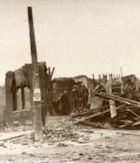 view into Rising City’s business scene throughout its history. One of the most notable commercial buildings in Rising City was a prominent brick building known as the Opera Block. This structure was built in 1892, and it was destroyed by fire in 1923. This collection includes scenes of the destroyed building after the fire.
view into Rising City’s business scene throughout its history. One of the most notable commercial buildings in Rising City was a prominent brick building known as the Opera Block. This structure was built in 1892, and it was destroyed by fire in 1923. This collection includes scenes of the destroyed building after the fire.
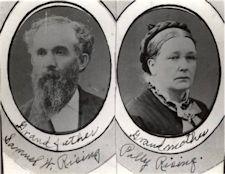 A group of portraits of members of the Rising family, after whom the town is named, is another highlight of this collection. Samuel W. Rising (seen here with his wife Polly) and his son Albert W. Rising each gave 40 acres of their land to be used for the Rising City town site. Portraits of Samuel’s other sons, Dennis and Joseph, are in the collection, as well.
A group of portraits of members of the Rising family, after whom the town is named, is another highlight of this collection. Samuel W. Rising (seen here with his wife Polly) and his son Albert W. Rising each gave 40 acres of their land to be used for the Rising City town site. Portraits of Samuel’s other sons, Dennis and Joseph, are in the collection, as well.
Take a moment and explore this collection to get a glimpse into Rising City history, and be sure to visit Nebraska Memories to search for or browse through many more historical images digitized from photographs, negatives, postcards, maps, lantern slides, books and other materials.
Nebraska Memories is a cooperative project to digitize Nebraska-related historical and cultural heritage materials and make them available to researchers of all ages via the Internet. Nebraska Memories is brought to you by the Nebraska Library Commission. If your institution is interested in participating in Nebraska Memories, see http://nlc.nebraska.gov/nebraskamemories/participation.aspx for more information, or contact Beth Goble, Historical Services Librarian, or Devra Dragos, Technology & Access Services Director.
Posted in Nebraska Memories
2 Comments
Going Postal…
In the more than two hundred years since Benjamin Franklin was appointed our first Postmaster General in 1775, the Postal Service™ has grown and changed with America. Not only have there been changes in moving the mail (ranging from the basic horse and rider Pony Express, to stagecoaches, trains, boats, airplanes, and even dog sled), but there have also been changes in post office buildings. The types of buildings used, and the architecture of Nebraska post offices through the years can easily be seen in the many photographs and postcards found in Nebraska Memories.
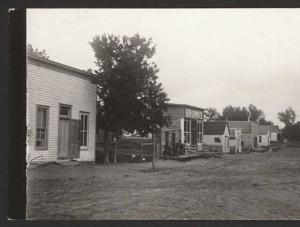 This first picture, taken by Nebraska photographer John Nelson, shows an early 1900’s Nebraska town with a dirt street lined with buildings. One of the stores has a sign on it that says, “Brown’s” which was also the post office.
This first picture, taken by Nebraska photographer John Nelson, shows an early 1900’s Nebraska town with a dirt street lined with buildings. One of the stores has a sign on it that says, “Brown’s” which was also the post office.
It was not uncommon for a general store to serve as the town post office as well. The building in this picture, with its’ plain front and wooden sidewalk, was not many years removed from and not much changed from frontier days style buildings.
Many buildings and businesses did double and even triple duty, like this undertaker, furniture and post office storefront in Papillion, Nebraska, circa 1907. 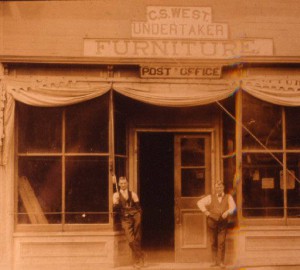
The building was located on the west side of Washington Street between First and Second Streets, but had a little more “modern” store front with big plate glass windows. Charles West (probably the man on the right) served as the Postmaster of Papillion from 1901 to 1914. The man on the left is an unidentified clerk.
This next photograph shows another style of wooden building with a sign identifying it as the Loomis post office. A long wooden porch covered by an awning runs the length of the building. The postmaster, Gust F. Carlson, stands on the porch, leaning against one of the awning’s support poles. Three other men stand with him, including Axel Veegert (second from right), a mail carrier. A car is parked on the dirt road in front of the building, with a container labeled “U.S. Mail” attached to its side. 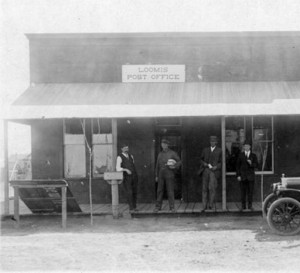
Wooden buildings gradually gave way to larger and more grand buildings, as evidenced by these photographs from Fremont, David City, and Omaha, respectively.
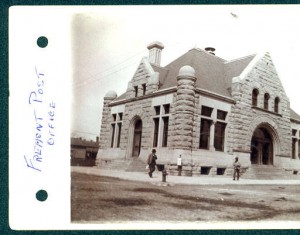 This Fremont post office building was on the northwest corner of Sixth and Broad Streets, built in 1893 in the more ornate Richardsonian Romanesque style. This style included the hipped roof with parapeted gable dormers, windows with rounded tops, deep-set windows with transoms, arched entries, and the contrasting smooth and rough wall textures.
This Fremont post office building was on the northwest corner of Sixth and Broad Streets, built in 1893 in the more ornate Richardsonian Romanesque style. This style included the hipped roof with parapeted gable dormers, windows with rounded tops, deep-set windows with transoms, arched entries, and the contrasting smooth and rough wall textures.
The David City post office was a one-story red brick building with wide steps leading to white double entry doors with arched contrasting brick-work above, arched windows with matching trim at each side of the door and smaller double-hung windows on the front and sides of the building, bushes around the foundation and lawn on two sides of the corner lot, a street light in front, sidewalks on two sides with brick streets in front. 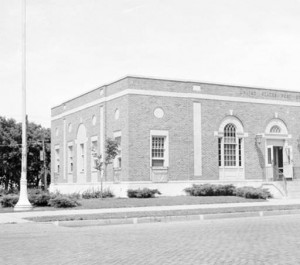
The postcard below, circa 1914, of the South Omaha branch of the post office, was located at 502 North 24th Street in South Omaha, Nebraska. The building was red brick, two stories tall, with arched windows and doors on the first floor and six columns on the front. 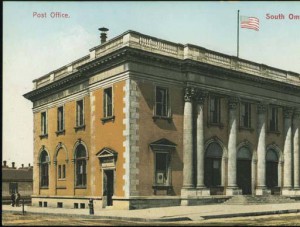
The layout of the interiors of buildings that were used as post offices are of interest as well, as seen in the following pictures.
The post Office in Spalding, Nebraska had a long cabinet with many pigeon-holes stuffed with letters, and the postmaster’s desk in front; 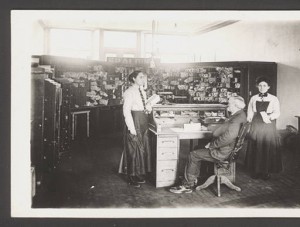
while another Post Office photograph shows a “Reading Room” where people could sit down at a desk to read their letters. 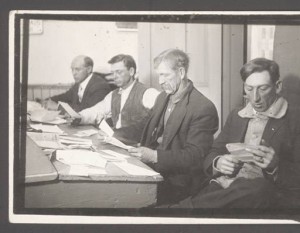
There is also this photograph of what the post office boxes at the back of the Potter, Nebraska general store looked like: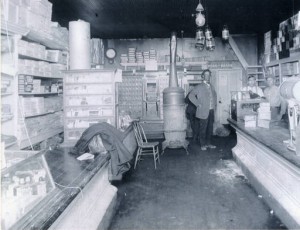
Thanks for joining me today as we journeyed back to look at Nebraska post office buildings from the past 100+ years. I hope you enjoyed it as much as I did!
Visit Nebraska Memories to search for or browse through many more historical images digitized from photographs, negatives, postcards, maps, lantern slides, books and other materials.
Nebraska Memories is a cooperative project to digitize Nebraska-related historical and cultural heritage materials and make them available to researchers of all ages via the Internet. Nebraska Memories is brought to you by the Nebraska Library Commission. If your institution is interested in participating in Nebraska Memories, see http://nlc.nebraska.gov/nebraskamemories/participation.aspx for more information, or contact Beth Goble, Historical Projects Librarian, or Devra Dragos, Technology & Access Services Director.
Posted in Nebraska Memories
Leave a comment
Recollections
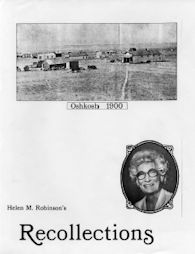 How good is your memory? The town of Oshkosh NE was lucky to have a resident with a great memory and willingness to document and share what she remembered. In June of 1984 someone from the Garden County News office contacted Helen M. Robinson asking her to write about her personal memories of different business in Oshkosh beginning in 1920. After thinking it over Helen agreed but with one condition. “That condition is, that it would also become a community project, to attempt to get a written record of the Oshkosh businesses from 1920 to the present time – 1984.” (Chapter 1; Page 1) I don’t know if she realize when she agreed how large of a project this would turn into. Her articles appeared in the Garden Count News from June 14, 1984 to December 4, 1986.
How good is your memory? The town of Oshkosh NE was lucky to have a resident with a great memory and willingness to document and share what she remembered. In June of 1984 someone from the Garden County News office contacted Helen M. Robinson asking her to write about her personal memories of different business in Oshkosh beginning in 1920. After thinking it over Helen agreed but with one condition. “That condition is, that it would also become a community project, to attempt to get a written record of the Oshkosh businesses from 1920 to the present time – 1984.” (Chapter 1; Page 1) I don’t know if she realize when she agreed how large of a project this would turn into. Her articles appeared in the Garden Count News from June 14, 1984 to December 4, 1986.
In 1985 Helen’s children decided that their mom’s newspaper articles should be placed in a more permanent form. After the last article was printed in 1986 they began working on compiling the articles into a book. For continuity and ease of reading they combined the articles and created chapters. The completed book was finished in July 1987 which also happened to be about the same time Helen celebrated her 80th birthday.
Today everyone can read and enjoy Helen M. Robinson’s Recollections. In 2014 the Garden County Historical Society, along with the Oshkosh Public Library, worked with the Library Commission to digitize the book and make it available in the Nebraska Memories. The book can be found at: http://memories.nebraska.gov/cdm/landingpage/collection/gchs
Reading the book I learn that Oshkosh has supported a wide variety of businesses over the years including barbers, shoe & harness repair, department stores, flower & gift shops, bakeries, cream stations, sales barns, cafes, manufacturing, morticians, cleaning establishments, ice cream parlors, hotels, hardware stores and filling stations. The amount of information Helen provides about each business is amazing. Many of these businesses changed locations over time and she documented all of their different locations, the names of the owners and employees.
Here is just a small portion of what I learned just about the banks in Oshkosh. In 1917 a second bank opened in town and was named the Oshkosh State Bank. It was located in a small building on the east side of Main Street until a two-story brick building was completed on the southwest corner of Main and Avenue C. The picture at the right shows the building during construction. In 1924 the Oshkosh State Bank and the Nebraska State Bank merged under the name Nebraska State Bank. The Nebraska State Bank moved its offices from their building which was located a block north to the brick building built by the Oshkosh State Bank. The newly formed bank was managed by Mr. Farrell.
My short paragraph is far from the complete history of the banks in Oshkosh. There is almost 60 more years’ worth of information in the book just about the banks. The information includes the names of many of the owners and employees starting in 1904 and continues on until the early 1980’s. Helen even provided the maiden names for many of the female employees. More information about the banks can be found in Chapter 10 of the book.
On a side note I do wonder what type of negotiations took place in 1924 when the banks merged. How did they decide to go with the name Nebraska State Bank yet at the same time locate their business in a brick building that had the name Oshkosh State Bank written in stone above the door? Looking at Google Map’s Street View you can see that the bank building is still standing 97 years later with the name Oshkosh State Bank still visible.
Reading through the book I was happy to see that Helen got her wish and her columns did turn into a community project. Throughout the book there are multiple references to what other folks remembered. Helen also included letters other folks sent her. One letter that I enjoyed was from Betty (Brennan) Beam. Betty’s letter talked about the first tea house in Oshkosh. She described it as “dark and without paint. Within was the odor of burning coals and soot.” As you read you realize the tea house she was describing was actually Jim Monshan’s blacksmith shop where the farmers would gather for a cup of tea. Betty said “Jim Monahan was English enough to make the tea and Irish enough to be blessed with quick wit and a ready answer.” (Chapter 7; Page 25)
I hope my comments about the book Helen M. Robinson’s Recollections have piqued your interest. The book is over 300 pages long. There are a lot of great memories of businesses and business people of Oshkosh. If you don’t have time to read the book cover to cover you can always search the book for specific name, business or any piece of information you think maybe included in the book.
Visit Nebraska Memories to search for or browse through many more historical images digitized from photographs, negatives, postcards, maps, lantern slides, books and other materials.
Nebraska Memories is a cooperative project to digitize Nebraska-related historical and cultural heritage materials and make them available to researchers of all ages via the Internet. Nebraska Memories is brought to you by the Nebraska Library Commission. If your institution is interested in participating in Nebraska Memories, see http://nlc.nebraska.gov/nebraskamemories/participation.aspx for more information, or contact Beth Goble, Historical Projects Librarian, or Devra Dragos, Technology & Access Services Director.
Beat of a Different Drummer
The group performing on the corner a block away for the Friday lunch hour, as I work on this blog post, not only reinforces the fact that everyone has their own taste in music and preference for a “beat” but also the importance of music to humans.
Music has played a big part in Nebraska’s cultural history; in Nebraska Memories, you can browse through our new category of Musical Performers which includes photographic images people of different times, ages, and backgrounds.

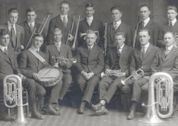
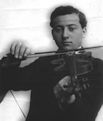 Some student musicians like young Madessa Wolfe, far left, (Harvey L. Boston, Butler County Gallery Collection) enjoyed private music lessons while others learned to play in school bands–high school or college like the 1917 Nebraska Normal College Band, above center, (Wayne State College Collection). Faculty at the University School of Music in Lincoln, such as Carl Steckelberg, above right, (Polley Music Library Collection) not only taught music but also performed regularly.
Some student musicians like young Madessa Wolfe, far left, (Harvey L. Boston, Butler County Gallery Collection) enjoyed private music lessons while others learned to play in school bands–high school or college like the 1917 Nebraska Normal College Band, above center, (Wayne State College Collection). Faculty at the University School of Music in Lincoln, such as Carl Steckelberg, above right, (Polley Music Library Collection) not only taught music but also performed regularly.
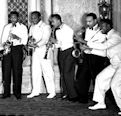
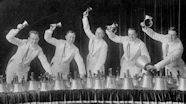 Outside of school, bands and orchestras were formed by families, friends, and church and community members. Some were amateurs while others were professional like this Orchestra featuring all male African American musicians, at left (William Wentworth, The Durham Museum Collection). For a time, performers the bell ringers to the left (Alva C. Townsend, Townsend Studio Collection) could be booked through the Chautauqua.
Outside of school, bands and orchestras were formed by families, friends, and church and community members. Some were amateurs while others were professional like this Orchestra featuring all male African American musicians, at left (William Wentworth, The Durham Museum Collection). For a time, performers the bell ringers to the left (Alva C. Townsend, Townsend Studio Collection) could be booked through the Chautauqua.
 Performers made music outdoors in bandstands, fields, parades or on a makeshift stage as in the photo to the right, of a man, boy and girl (John Nelson, Nebraska State Historical Society Collection). Indoor venues included school stages, auditoriums, churches, ball rooms, concert halls, opera houses, prisoner of war camps, orphanages and other institutions.
Performers made music outdoors in bandstands, fields, parades or on a makeshift stage as in the photo to the right, of a man, boy and girl (John Nelson, Nebraska State Historical Society Collection). Indoor venues included school stages, auditoriums, churches, ball rooms, concert halls, opera houses, prisoner of war camps, orphanages and other institutions.
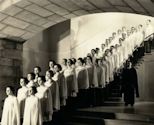 Choirs also played an important role in the musical scene. The Great Cathedral Choir shown here in the State Capitol (Polley Music Library Collection) performed regularly in Lincoln starting in 1919. Singers also played parts on stage in musicals or took part in concerts. The Polley Music Library Collection includes many concert programs featuring visiting and local performers.
Choirs also played an important role in the musical scene. The Great Cathedral Choir shown here in the State Capitol (Polley Music Library Collection) performed regularly in Lincoln starting in 1919. Singers also played parts on stage in musicals or took part in concerts. The Polley Music Library Collection includes many concert programs featuring visiting and local performers.
 So, whether you prefer an indoor or outdoor performance, a formal orchestra or the beat of a single drummer like Chief Bear Dog (John Anderson, Nebraska State Historical Society Collection), take a look at the items representing the rich musical history of Nebraska.
So, whether you prefer an indoor or outdoor performance, a formal orchestra or the beat of a single drummer like Chief Bear Dog (John Anderson, Nebraska State Historical Society Collection), take a look at the items representing the rich musical history of Nebraska.
Visit Nebraska Memories to search for or browse through many more historical images digitized from photographs, negatives, postcards, maps, lantern slides, books and other materials.
Nebraska Memories is a cooperative project to digitize Nebraska-related historical and cultural heritage materials and make them available to researchers of all ages via the Internet. Nebraska Memories is brought to you by the Nebraska Library Commission. If your institution is interested in participating in Nebraska Memories, see http://nlc.nebraska.gov/nebraskamemories/participation.aspx for more information, or contact Beth Goble, Historical Projects Librarian, or Devra Dragos, Technology & Access Services Director.
Posted in Nebraska Memories
Leave a comment
